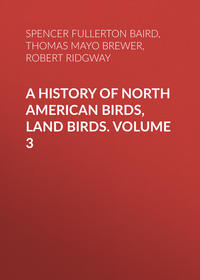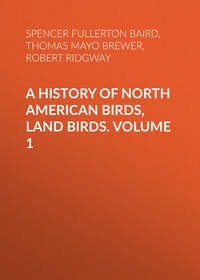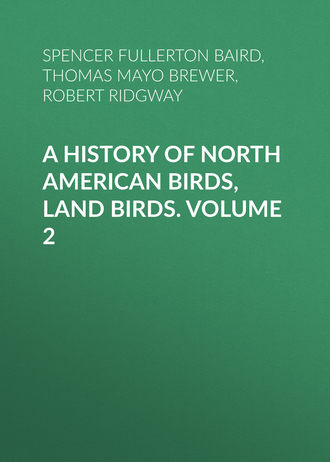 полная версия
полная версияA History of North American Birds, Land Birds. Volume 2
E. americana. Top and sides of head light slate; forehead tinged with greenish-yellow. A superciliary stripe, a maxillary spot, sides of breast, and middle line of breast and belly, yellow. Chin white, throat black, shoulders chestnut. Female with the black of the throat replaced by a crescent of spots. Hab. Eastern Province of United States; south to New Grenada.
E. townsendi. Body throughout (including the jugulum), dark ash, tinged with brownish on the back and wings. Superciliary and maxillary stripe, chin, throat, and middle of belly, white. A maxillary line and a pectoral crescent of black spots. No chestnut shoulders. Hab. Chester Co., Pennsylvania.
Euspiza americana, BonapBLACK-THROATED BUNTINGEmberiza americana, Gmelin, Syst. Nat. I, 1788, 872.—Wilson, Am. Orn. III, 1811, 86, pl. iii, f. 2.—Aud. Orn. Biog. IV, 1838, 579, pl. ccclxxxiv.—Ib. Syn. 1839, 101.—Ib. Birds Am. III, 1841, 58, pl. clvi.—Max. Cab. J. VI, 1858, 341. Fringilla (Spiza) americana, Bonap. Obs. Wils. 1825, No. 85. Euspiza americana, Bonap. List, 1838 (type).—Ib. Conspectus, 1850, 469.—Baird, Birds N. Am. 1858, 494.—Samuels, 327. Euspina americana, Cabanis, Mus. Hein. 1851, 133 (type). Fringilla flavicollis, Gmelin, Syst. Nat. I, 926. “Emberiza mexicana, Latham,” Syn. I, 1790, 412 (Gray). Passerina nigricollis, Vieillot. Yellow-throated Finch, Pennant, Arc. Zoöl. II, 374.
Sp. Char. Male. Sides of the head and sides and back of the neck ash; crown tinged with yellowish-green and faintly streaked with dusky. A superciliary and short maxillary line, middle of the breast, axillaries, and edge of the wing yellow. Chin, loral region, patch on side of throat, belly, and under tail-coverts white. A black patch on the throat diminishing to the breast, and ending in a spot on the upper part of the belly. Wing-coverts chestnut. Interscapular region streaked with black; rest of back immaculate. Length, about 6.70; wing, 3.50.
Female with the markings less distinctly indicated; the black of the breast replaced by a black maxillary line and a streaked collar in the yellow of the upper part of the breast.
Hab. United States from the Atlantic to the border of the high Central Plains, south to Panama and New Granada. Xalapa (Scl. 1857, 205); Guatemala (Scl. Ibis, I, 18); Turbo, N. G. (Cassin, P. A. N. S. 1860, 140); Panama (Lawr. VII, 1861, 298); Nicaragua, Graytown (Lawr. VIII, 181); Veragua (Salv. 1867, 142); Costa Rica (Lawr. IX, 103); Vera Cruz, winter (Sum. M. B. S. I, 552).
Among adult males, scarcely two individuals exactly alike can be found. In some the black of the throat is continued in blotches down the middle of the breast, while in others it is restricted to a spot immediately under the head. These variations are not at all dependent upon any difference of habitat, for specimens from remote regions from each other may be found as nearly alike as any from the same locality. Some specimens from Central America are more deeply colored than North American ones, owing, no doubt, to the freshness of the plumage.
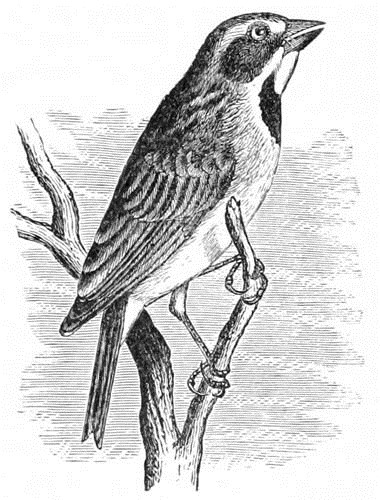
Euspiza americana.
Habits. The history of the Black-throated Bunting has, until very recently, been much obscured by incorrect observations and wrong descriptions. Evidently this bird has been more or less confounded with one or two other species entirely different from it. Thus Wilson, Audubon, and Nuttall, in speaking of its nest and eggs, give descriptions applicable to Coturniculus passerinus or to C. henslowi, but which are wholly wrong as applied to those of this bird. Nuttall, whose observations of North American birds were largely made in Massachusetts, speaks of this bird being quite common in that State, where it is certainly very rare, and describes, as its song, notes that have no resemblance to those of this Bunting, but which are a very exact description of the musical performances of the Yellow-winged Sparrow.
It is found in the eastern portion of North America, from the base of the Black Hills to the Atlantic States, and from Massachusetts to South Carolina. I am not aware that on the Atlantic it has ever been traced farther south than that State, but farther west it is found as far at least as Southwestern Texas. During winter it is found in Central America, and in Colombia, South America.
In Massachusetts it is extremely rare. Mr. Hopkins found it breeding in Williamstown, and sent me its eggs. I have also met with its nest and eggs, in a low meadow near the sea, in Hingham. In both of these instances the nest was on the ground. A specimen was shot in Newton by Mr. John Thaxter, June 26, 1857, that had all the appearance of being then in the process of incubation. Throughout Pennsylvania, and in the vicinity of Washington, these birds are quite common.
Wilson states that they are very common in the vicinity of Philadelphia, where they make their appearance in the middle of May, and where they seem to prefer level fields covered with rye-grass, clover, or timothy. They are described as more conspicuous for the quantity than for the quality of their song. This consists of three notes, sounding like chip-chip-chē-chē-chē. Of this unmusical ditty they are by no means parsimonious, and for nearly three months after their first arrival, every level field of grain or grass resounds with their quaint serenade. In their shape and manners, Wilson states, they bear a close resemblance to the Emberiza citrinella of Europe. They become silent by September, and in the course of that month depart for the southwest. It is a rare bird in South Carolina, but is very abundant in Texas, where it is also resident, and undoubtedly breeds. Audubon states that he was surprised to see how numerous they were in every open piece of ground throughout that State, especially those covered with tufts of grass. They are, he states, not so common in Ohio, and quite rare in Kentucky. They are especially abundant in the open lands of Indiana, Illinois, Wisconsin, Iowa, Missouri, Kansas, and Nebraska; and they have been found breeding as far to the west as Wyoming Territory, near to the base of the eastern range of the Rocky Mountains. Mr. Allen found this species one of the most abundant birds of Western Iowa, characterizing it as eminently a prairie species, and one of the few inhabitants of the wide open stretches.
Mr. Dresser found, early in May, numbers of these birds in the mesquite thickets near the San Antonio and Medina Rivers, and, as he found them equally numerous there in July, he naturally infers that they breed in that neighborhood. Dr. Heermann obtained some eggs which he had no doubt belonged to this species, though he was unable to secure the parent.
It has also been found in Western Texas and in the Indian Territory by Mr. J. H. Clark, in Texas by Dr. Lincecum, at the Kiowa agency by Dr. Palmer, and on the Yellowstone by Dr. Hayden.
This bird is not gregarious, always moving in pairs, and although, as they are preparing for their migrations, they congregate in particular localities, they always keep somewhat apart in family groups, and do not mingle promiscuously as do many others of this family. They are, at all times, unsuspicious and easily approached, and when fired at will often return to the same field from which they were startled. They are very partial to certain localities, and are rarely to be met with in sandy regions.
Mr. Audubon states that the notes of this species very closely resemble those of the Emberiza miliaria of Europe. Its unmusical notes are almost continuously repeated from sunrise to sunset. When the female is startled from her nest she creeps quietly away through the grass, and then hides herself, making no complaint, and not showing herself even if her treasures are taken from her. Their nests are constructed of coarse grasses and stems, lined with finer and similar materials. They are, in certain localities, placed on the ground, but more frequently, in many parts of the country, they are built in positions above the ground. This is almost invariably the case where they nest among the tall coarse grasses of the prairies. My attention was first called to this peculiarity by Dr. J. W. Velie, then of Rock Island, Ill. He informed me that in no instance had he found the nest of this species on the ground, but always raised a few inches above it. It was usually constructed of the tops of the red-top grasses, worked in among a bunch of thick grass, so as to make the nest quite firm. The meadows in which Dr. Velie found these nests were quite dry, so that there was no necessity for their thus building clear from the ground in order to escape being wet. I was afterwards informed by the late Mr. Robert Kennicott that his experience in regard to the nests of these birds had been invariably the same. Dr. P. R. Hoy, of Racine, is confident that these birds in Wisconsin never nest on the ground, or else very rarely, as he has never noticed their doing so. He writes that during one season he visited and made notes of nineteen different nests. Ten of these were built in gooseberry-bushes, four on thorn-bushes, three among blackberry-brambles, one on a raspberry-bush, and one on a wild rose. None were within a foot of the ground, and some were six feet from it. They have two broods in a season.
On the other hand, Mr. Ridgway informs me that in Southern Illinois the nest of this species is always placed on the ground, usually in a meadow, and that he has never found its nest placed anywhere else than on the ground, in a tuft of grass or clover. Professor Baird has had a similar experience in Pennsylvania. Mr. B. F. Goss found them nesting both in bushes and on the ground at Neosho Falls, Kansas.
The eggs of this species are of a uniform light blue color, similar in shade to the eggs of the common Bluebird, as also to those of the Calamospiza bicolor. They vary considerably in size, the smallest measuring .80 of an inch in length by .60 in breadth, while the larger and more common size is .90 by .70 of an inch.
Euspiza townsendi, BonapTOWNSEND’S BUNTINGEmberiza townsendi, Aud. Orn. Biog. II, 1834, 183; V, 90, pl. cccc.—Ib. Syn. 1839.—Ib. Birds Am. III, 1841, 62, pl. clvii.—Nuttall, Man. I, (2d ed.,) 1840, 528. Euspiza townsendi, Bon. List, 1838.—Baird, Birds N. Am. 1858, 495.
Sp. Char. Male. Upper parts, head and neck all round, sides of body and forepart of breast, slate-blue; the back and upper surface of wings tinged with yellowish-brown; the interscapular region streaked with black. A superciliary and maxillary line, chin and throat, and central line of under parts from the breast to crissum, white; the edge of the wing, and a gloss on the breast and middle of belly, yellow. A black spotted line from the lower corner of the lower mandible down the side of the throat, connecting with a crescent of streaks in the upper edge of the slate portion of the breast. Length, 5.75; wing, 2.86; tail, 2.56.
Hab. Chester County, Penn. But one specimen known (in the Mus. Smith.).
It is still a question whether this is a distinct species, or only a variety of E. americana. There is, however, little ground for the last supposition, although its rarity is a mystery.
The original type specimen of this species, collected by Dr. J. K. Townsend, still continues to be the only one known, and has been presented by its owner, Dr. E. Michener, to the Smithsonian Institution.
Habits. Only a single specimen of this apparently well-marked species has been observed, and nothing is known as to its history. The bird was shot by Mr. J. K. Townsend, in an old field grown up with cedar-bushes, near New Garden, Chester Co. Penn., May 11, 1833.
Genus HEDYMELES, Cabanis? Goniaphea, Bowd. “Excurs. in Madeira, 1825,” Agassiz. (Type, Loxia ludoviciana, according to Gray.)
Habia, Reichenb. Av. Syst. Nat. 1850, pl. xxviii. (Type, L. ludoviciana; not Habia of Lesson, 1831).
Hedymeles, Cabanis, Mus. Hein. 1851, 153. (Same type.)

Hedymeles melanocephalus.
1496 ♂
Gen. Char. Bill very large, much swollen; lower mandible scarcely deeper than the upper; feet almost coccothraustine, tarsi and toes very short, the claws strong and much curved, though blunt. First four primaries longest, and nearly equal, abruptly longer than the fifth. Tail broad, perfectly square. Colors: Black, white, and red, or black, cinnamon, yellow, and white, on the male; the females brownish, streaked, with the axillars and lining of the wing yellow.
There seems to be abundant reason for separating this genus from Guiraca; the latter is, in reality, much more nearly related to Cyanospiza, it being impossible to define the dividing line between them.
Species and VarietiesCommon Characters. ♂. Head and upper parts (except rump) deep black. Two broad bands across coverts, a large patch on base of primaries, and terminal half of inner webs of tail-feathers, pure white. Breast carmine or cinnamon; axillars and lining of wing carmine or gamboge. ♀. Black replaced by ochraceous-brown; other parts more streaked.
H. ludovicianus. Rump and lower parts white; lining of wing, and patch on breast, rosy carmine. No nuchal collar. Female. Lining of wing saffron-yellow; breast with numerous streaks. Hab. Eastern Province of North America, south, in winter, to Ecuador.
H. melanocephalus. Rump and lower parts cinnamon-rufous; lining of wing and middle of abdomen gamboge-yellow. A nuchal collar of rufous. Female. Lining of wing lemon-yellow; breast without streaks; abdomen tinged with lemon-yellow.
Crown continuous black. No post-ocular rufous stripe. Hab. Mountains of Mexico, and Central Rocky Mountains of United States … var. melanocephalus.
Crown divided by a longitudinal rufous stripe; a distinct post-ocular stripe of the same. Hab. Western Province of United States, south, in winter, to Colima … var. capitalis.
Hedymeles ludovicianus, SwainsonROSE-BREASTED GROSBEAKLoxia ludoviciana, Linn. Syst. Nat. I, 1766, 306.—Wilson, Am. Orn. >II, 1810, 135, pl. xvii, f. 2. Guiraca ludoviciana, Swainson, Phil. Mag. I, 1827, 438.—Bonap. List, 1838.—Ib. Consp. 1850, 501.—Baird, Birds N. Am. 1858, 497.—Samuels, 328. Fringilla ludoviciana, Aud. Orn. Biog. II, 1834, 166; V, 513, pl. cxxvii. Pyrrhula ludoviciana, Sab. Zoöl. App. Franklin’s Narr. Coccothraustes ludoviciana, Rich. List, Pr. Br. Ass. 1837. Coccoborus ludovicianus, Aud. Syn. 1839, 133.—Ib. Birds Am. III, 1841, 209, pl. 205.—Max. Cab. J. VI, 1858, 267. “Goniaphea ludoviciana, Bowdich.” Hedymeles ludoviciana, Cabanis, Mus. Hein. 1851, 153. Fringilla punicea, Gmelin, Syst. Nat. I, 1788, 921 (male). Loxia obscura, Gmelin, I, 1788, 862. Loxia rosea, Wilson, Am. Orn. pl. xvii, f. 2. Coccothraustes rubricollis, Vieillot, Galerie des Ois. I, 1824, 67, pl. lviii.
Sp. Char. Upper parts generally, with head and neck all round, glossy black. A broad crescent across the upper part of the breast, extending narrowly down to the belly, axillaries, and under wing-coverts, carmine. Rest of under parts, rump and upper tail-coverts, middle wing-coverts, spots on the tertiaries and inner great wing-coverts, basal half of primaries and secondaries, and a large patch on the ends of the inner webs of the outer three tail-feathers, pure white. Length, 8.50 inches; wing, 4.15.
Female without the white of quills, tail, and rump, and without any black or red. Above yellowish-brown streaked with darker; head with a central stripe above, and a superciliary on each side, white. Beneath dirty white, streaked with brown on the breast and sides. Under wing-coverts and axillars saffron-yellow.
In the male the black feathers of the back and sides of the neck have a subterminal white bar. There are a few black spots on the sides of the breast just below the red.
The young male of the year is like the female, except in having the axillaries, under wing-coverts, and a trace of a patch on the breast, light rose-red.
The depth of the carmine tint on the under parts varies a good deal in different specimens, but it is always of the same rosy hue.
Hab. Eastern United States to the Missouri plains; south to Ecuador. Honduras (Moore, P. Z. S. 1859, 58); Xalapa (Scl. 1859, 365); Bogota (Scl. 1855, 154); Cordova (Scl. 1856, 301); Guatemala (Scl. Ibis, I, 17); Cuba (Cab. J. VI, 9); Ecuador (Scl. 1860, 298); Costa Rica (Cab. J. 61, 71); (Lawr. IX, 102); Panama (Lawr. VII, 1861, 297); Vera Cruz, winter (Sum. M. B. S. I, 552); Yucatan (Lawr. Ann. IX, 210).
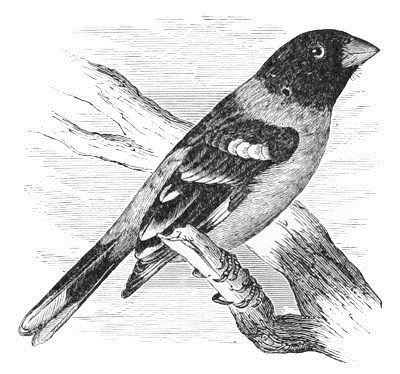
Hedymeles melanocephalus.
Habits. The Rose-breasted Grosbeak, during the summer months, appears to have a widely extended area of distribution, though nowhere a very abundant species, and one of somewhat irregular occurrence. It is found as far to the east as Nova Scotia, to the north as Selkirk Settlement and the valley of the Saskatchewan, and to the west as Nebraska. It winters in great numbers in Guatemala. In the last-named country, while abundant in the Vera Paz, it was not found at Dueñas, but was a common cage-bird in the city of Guatemala. It was also found common at Herradura, in Colombia, South America, by Mr. C. W. Wyatt.
This bird was noticed on a single occasion near San Antonio by Mr. Dresser, but was not observed by Dr. Woodhouse in Texas, or in the Indian Territory. Sumichrast did not meet with it in Vera Cruz. At St. Stephens, N. B., Mr. Boardman found this species a regular summer visitant, but rare, nor did Mr. Verrill find it common in the western part of Maine. In Massachusetts this bird becomes more common, but is nowhere very abundant. It has been met with in various places in the eastern part of the State, but rarely, and only in restricted localities. In the western part of the State it is more numerous, as well as throughout the whole of the Connecticut Valley. At Springfield, Mr. Allen notes it as a summer visitant, breeding in the open woods, but not abundant. He is of the opinion that during the past twenty-five years this bird has increased in numbers in all parts of the State. Mr. Allen found this bird quite common in Southern Indiana, in Northern Illinois, and in Western Iowa, where he found it frequent in the groves along the streams. Dr. Coues mentions it as rare and only migratory in South Carolina. Mr. McIlwraith gives it as a summer resident in the vicinity of Hamilton, Canada, where it is very generally distributed throughout the open woods, arriving there the second week in May. It is also found throughout Vermont, in favorable situations in open woods, on the borders of streams. It is not uncommon in the vicinity of Randolph, where it regularly breeds.
Wilson, who enjoyed but few opportunities of studying the habits of this species, states that it eagerly feeds on the ripe fruit of the sour gum-tree. He was also aware of its fine song, its value as a caged bird, and that it frequently sings during the night.
Sir John Richardson met with a single specimen of this bird near the Saskatchewan during his first expedition with Sir John Franklin, but did not afterwards meet with it. He states that it frequents the deep recesses of the forests, and there sings a clear, mellow, and harmonious song.
Nuttall appears to have seen little or nothing of this bird, except in confinement. He describes it as thriving very well in a cage, and as a melodious and indefatigable warbler, frequently passing the greater part of the night in singing, with great variety of tones. It is said, while thus earnestly engaged, to mount on tiptoe, as if seemingly in an ecstasy of enthusiasm and delight at the unrivalled harmony of its own voice. These notes, he adds, are wholly warbled, now loud and clear, now with a querulous and now with a sprightly air, and finally lower and more pathetic. In Mr. Nuttall’s opinion it has no superior in song, except the Mocking-Bird.
Mr. Say met with these birds in the spring, on the banks of the Missouri, and afterwards, on the 5th of August, at Pembina in the 49th degree of latitude.
This bird arrives in Eastern Massachusetts about the 15th of May, and leaves in September. It nests during the first week in June.
Mr. Audubon states that he has frequently observed this species, early in the month of March, in the lower parts of Louisiana, making its way eastward, and has noticed the same circumstance both at Henderson, Ky., and at Cincinnati, O. At this period it passes at a considerable height in the air. He never saw it in the maritime parts of Georgia or Carolina, but they have been procured in the mountainous parts of those States. On the banks of the Schuylkill, early in May, he has observed this bird feeding on the tender buds of the trees. When in Texas, in 1837, Mr. Audubon also found it very abundant in April.
Dr. Bachman, quoted by Audubon, states that, having slightly wounded a beautiful male of this species, he kept it three years in confinement. It very soon became quite tame, fed, in an open room, on moistened bread. It was at once reconciled to live in a cage, and fed readily on various kinds of food, but preferred Indian meal and hemp-seed. It was also very fond of insects, and ate grasshoppers and crickets with peculiar relish. It watched the flies with great apparent interest, and often snatched at and secured the wasps that ventured within its cage. During bright moonshiny nights it sang sweetly, but not loudly, remaining in the same position on its perch. When it sang in the daytime it was in the habit of vibrating its wings, in the manner of the Mocking-Bird. It was a lively and a gentle companion for three years, but suffered from cold in severe wintry weather, and finally died from this cause. It would frequently escape from its cage, and never exhibited the least desire to leave him, but always returned to the house at night. It sang about eight weeks, and the rest of the year had only a faint chuck.

PLATE XXX.
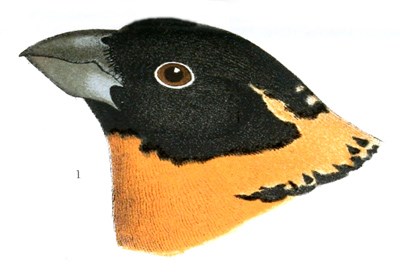
1. Hedymeles melanocephalus. ♂ Ft. Bridger, 11241.
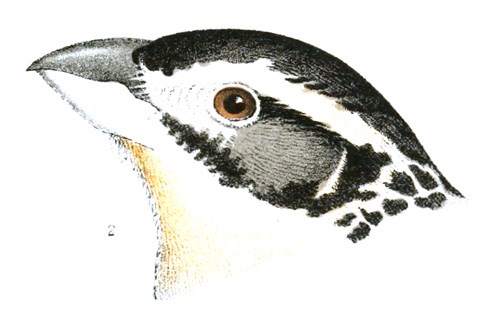
2. Hedymeles melanocephalus. ♀ Dakota, 1868.

3. Pyrrhuloxia sinuata. ♂ Texas, 3670.
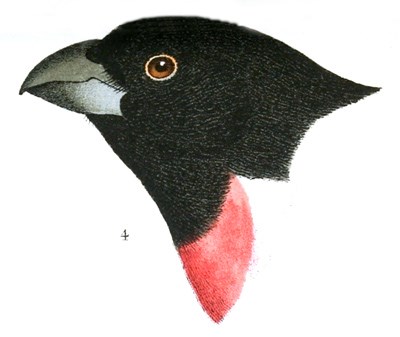
4. Hedymeles ludovicianus. ♂ Iowa, 34206.
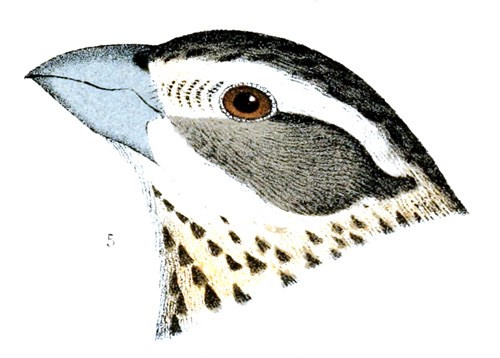
5. Hedymeles ludovicianus. ♀ Pa., 2425.
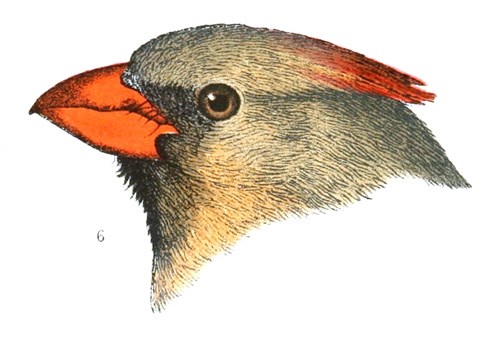
6. Cardinalis virginianus. ♀ Texas, 4022.
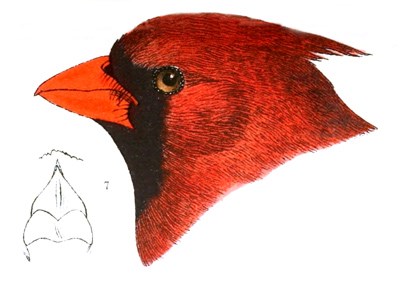
7. Cardinalis virginianus. ♂ S. Ill., 58586.
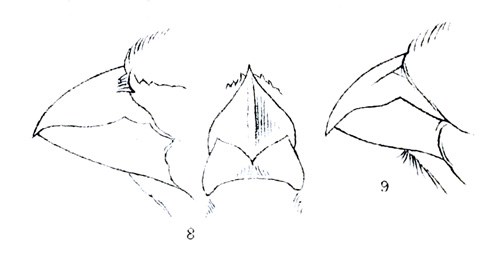
8. Cardinalis coccineus. ♂ 29702.
9. Cardinalis phœniceus.
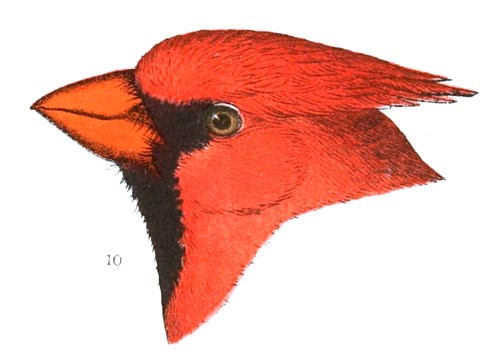
10. Cardinalis igneus. ♂ Cape St. Lucas, 49757.
This Grosbeak builds in low trees on the edge of woods, frequently in small groves on the banks of streams. Their nests are coarsely built, with a base composed of waste stubble, fragments of leaves, and stems of plants. These are intermingled with and strengthened by twigs and coarser stems. They have a diameter of eight inches, and a height of three and a half. The upper portion of the nest is usually composed of dry usnea mosses, mingled with a few twigs, and lined with finer twigs. Its cavity is three inches in diameter and one in depth, being quite shallow for so large a nest.


